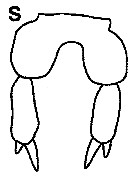|
|
 |
|
Calanoida ( Order ) |
|
|
|
Calanoidea ( Superfamily ) |
|
|
|
Paracalanidae ( Family ) |
|
|
|
Parvocalanus ( Genus ) |
|
|
| |
Parvocalanus latus Andronov, 1972 (F) | |
| | | | | | | Ref.: | | | Andronov, 1972 (p.139, Descr.F, figs.F); Bradford, 1978 (p.133); Hiromi, 1987 (p.153, fig.F); Kesarkar & Anil, 2010 (Rem.: p.406, fig.5,S and non 5,R); S.Y. Moon & al., 2014 (p.45: F) |  issued from : Andronov V.N. in Zool. Zh., 1972, 51 (1). [p.139, Fig.1]. Female (from 7°09N, 77°44E): 1-2, habitus (dorsal and lateral, respectively); 3, rostrum; 4-7, P1 to P4; 8-9, genital segment (ventral and lateral, respectively); 10, P5.
|
 issued from : K.S. Kesarkar & A.C. Anil in J. mar. Biol. Ass. UK, 2010, 90 (2); [p.406, Table 2]. Characteristics of females.
|
 issued from : K.S. Kesarkar & A.C. Anil in J. mar. Biol. Ass. UK, 2010, 90 (2); [p.407, Fig.5, S]. Female: S, P5. [indicated R in the legend by error, C.R.]
|
 Issued from : S. Y. Moon, S.-H. Youn & H.Y. Soh in ZooKeys, 2014, 456. [p.42, Table I]. Female : marphological characters. Compare with other species of Parvocalanus : ( P/ arabiensis, crassirostris, dubia, elegans, leei, serratipes, scotti).
| | | | | Compl. Ref.: | | | Madhupratap & Haridas, 1986 (p.105, tab.1); Othman & al., 1990 (p.561, 563, Table 1); Uysal & al., 2002 (p.17, tab.1); Zenetos & al., 2005 (p.63, Rem.: p.82, casual occurrence); Zenetos & al., 2010 (p.397); Uysal & Shmeleva, 2012 (p.909, Table I) | | | | NZ: | 3 | | |
|
Distribution map of Parvocalanus latus by geographical zones
|
| | | | | | | | | | Loc: | | | E Medit. (NW Lebanon Basin) (in Uysal & al., 2002), N Indian (Sri Lanka), Australia (G. of Carpentaria, in Othman & al., 1990) | | | | N: | 7 | | | | Lg.: | | | (439) F: 0,47-0,42; {F: 0,42-0,47} | | | | Rem.: | epiplagic (0-100 m). | | | Last update : 06/04/2018 | |
|
|
 Any use of this site for a publication will be mentioned with the following reference : Any use of this site for a publication will be mentioned with the following reference :
Razouls C., Desreumaux N., Kouwenberg J. and de Bovée F., 2005-2025. - Biodiversity of Marine Planktonic Copepods (morphology, geographical distribution and biological data). Sorbonne University, CNRS. Available at http://copepodes.obs-banyuls.fr/en [Accessed November 06, 2025] © copyright 2005-2025 Sorbonne University, CNRS
|
|
 |
 |






